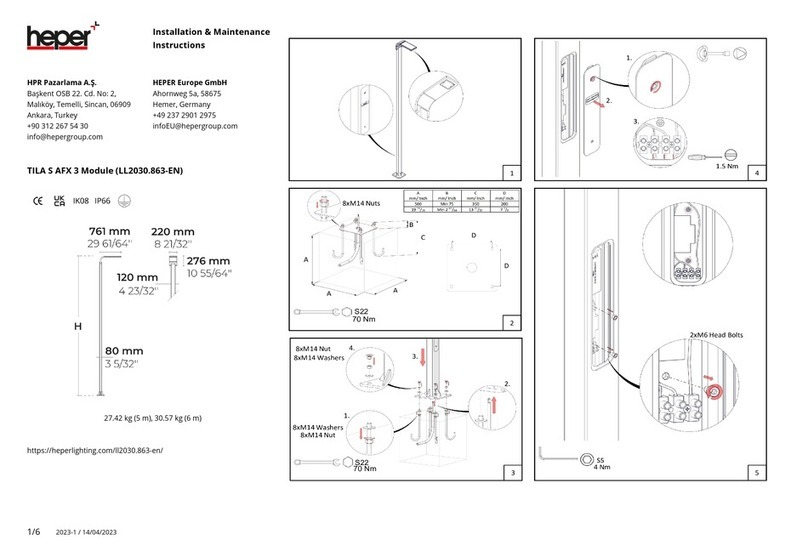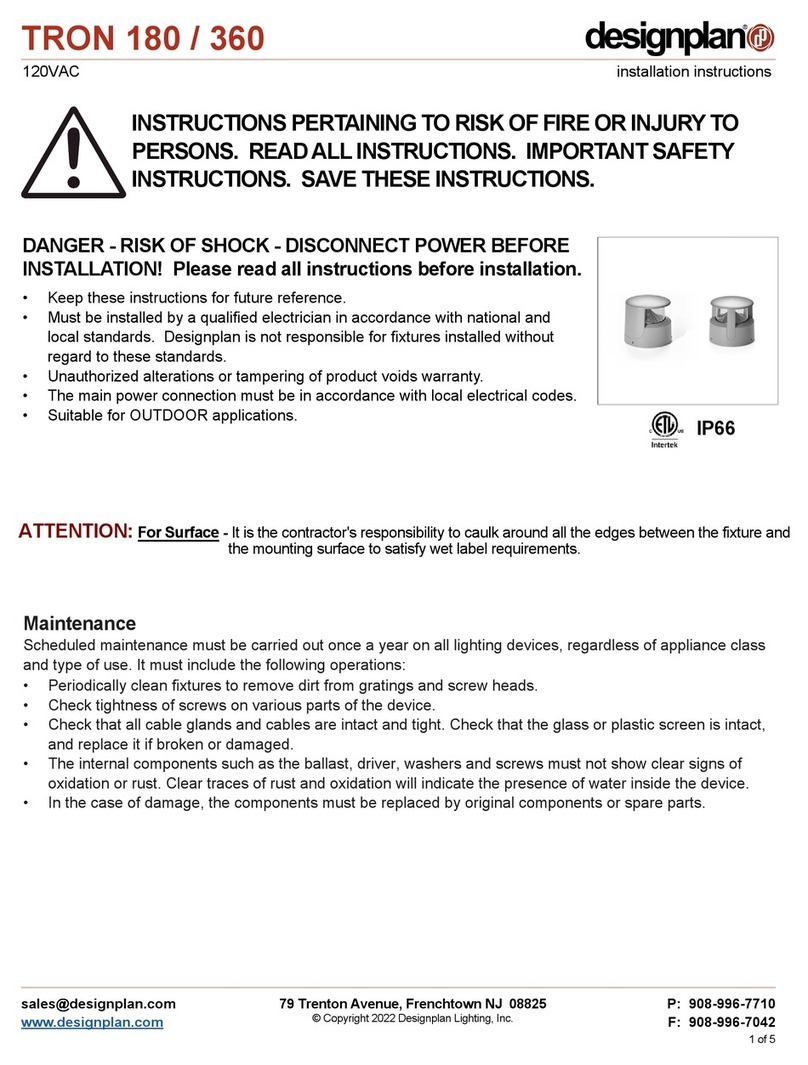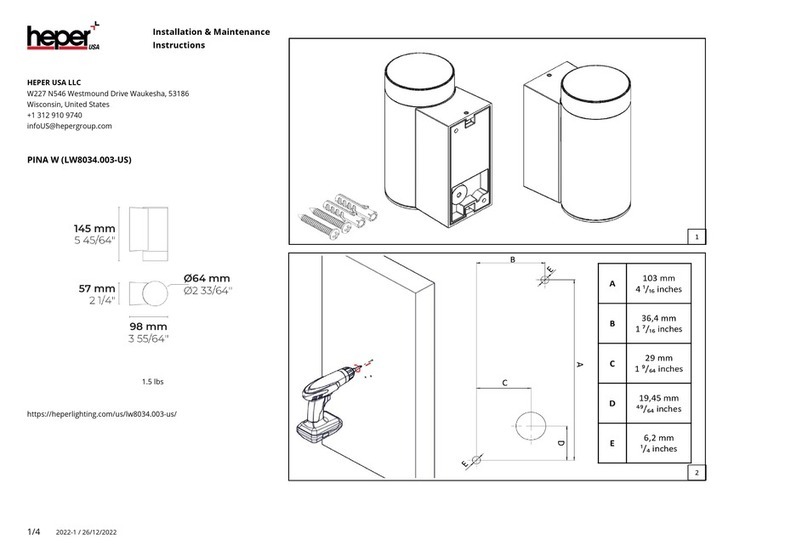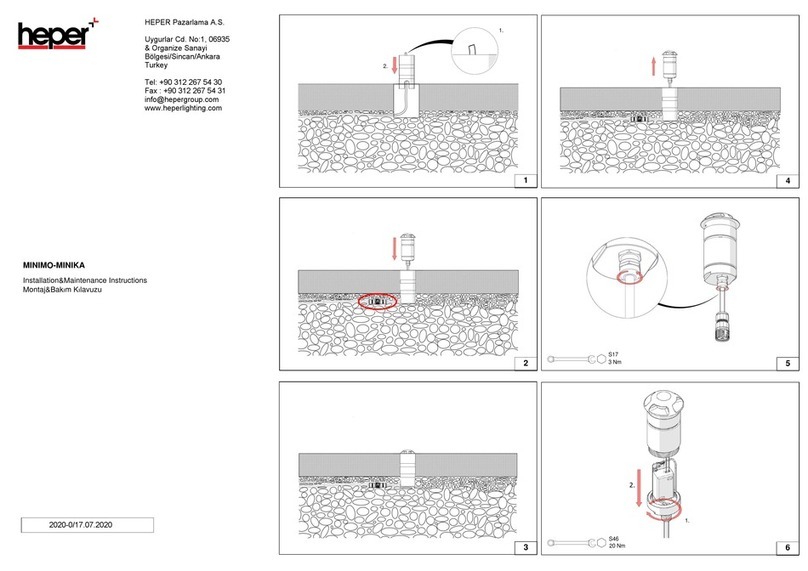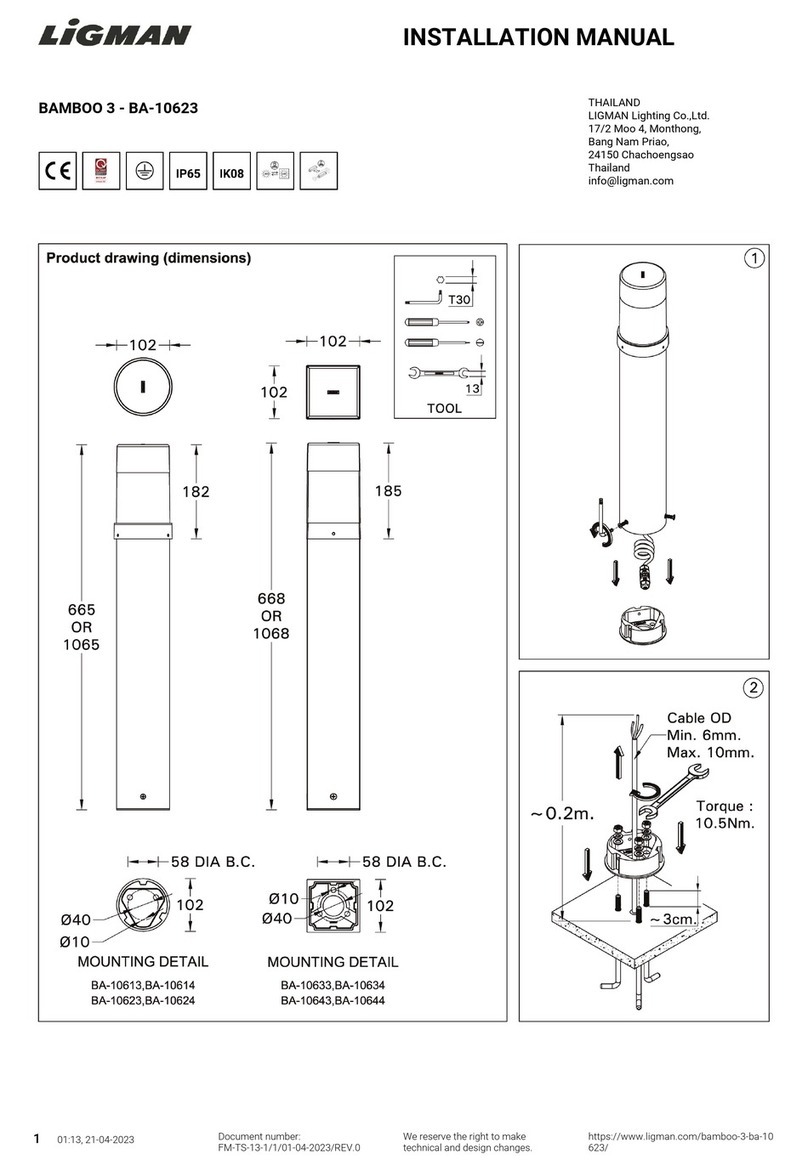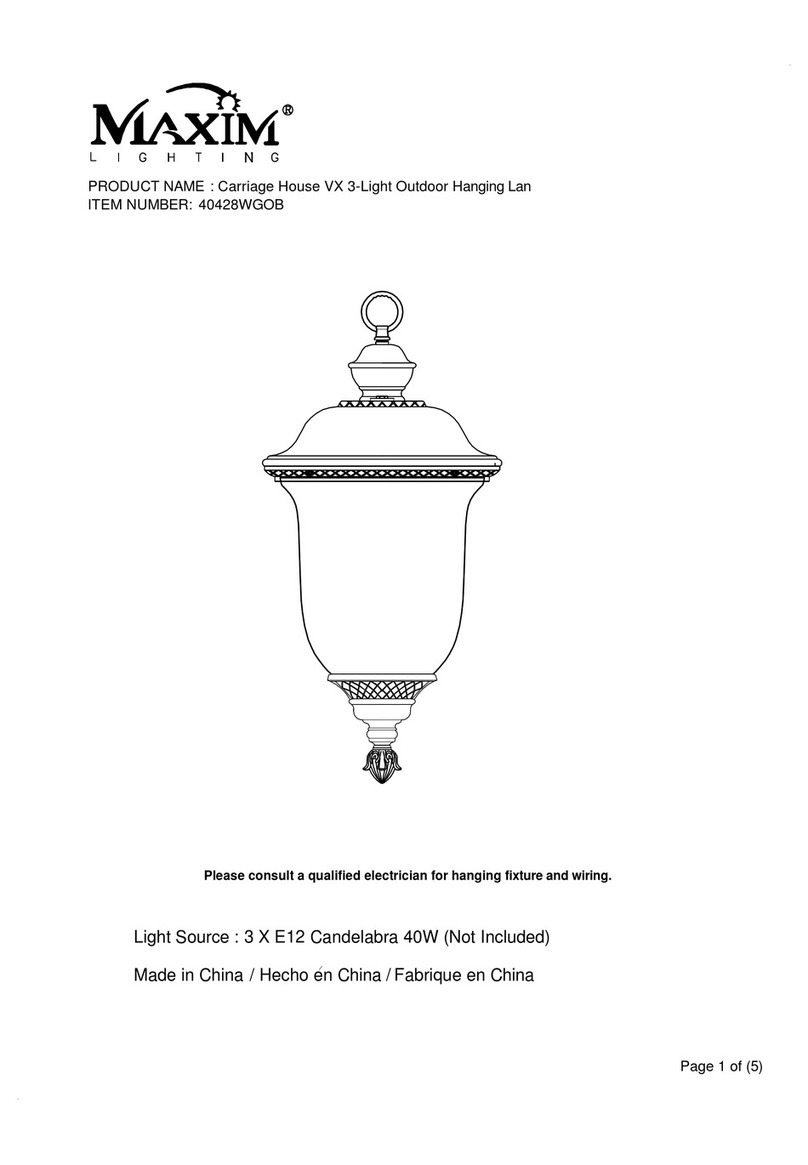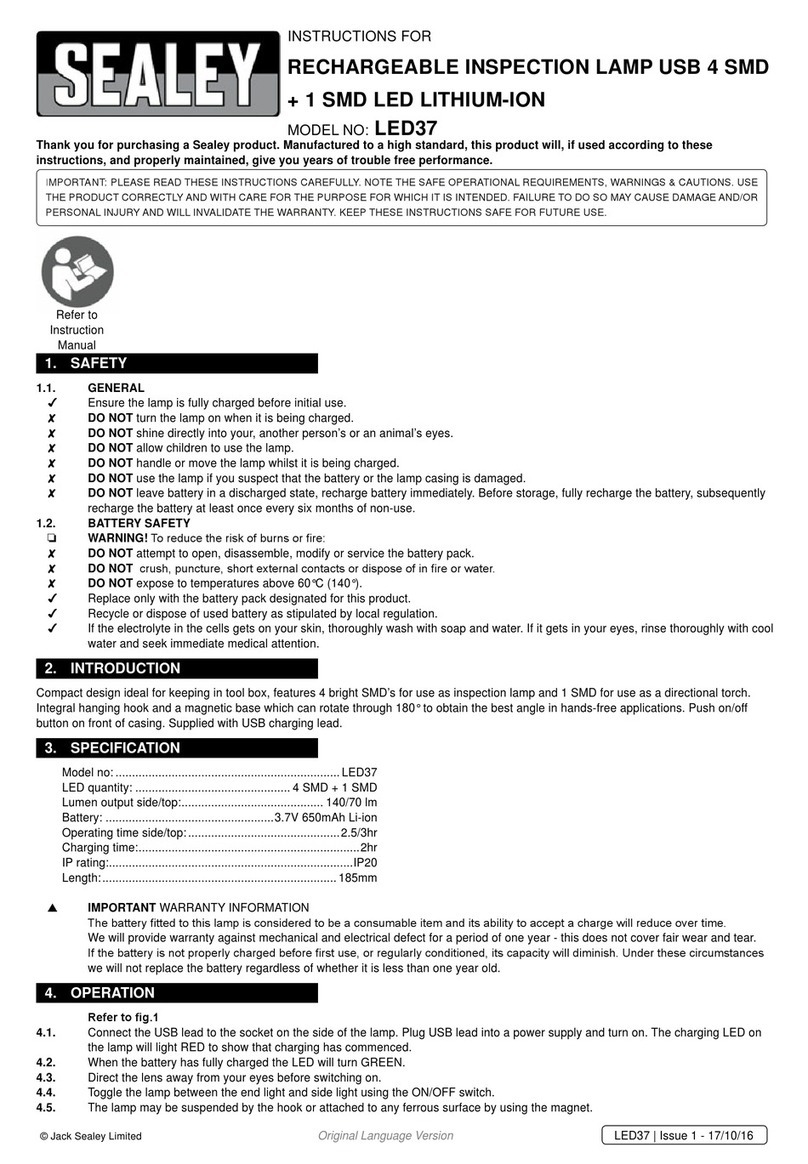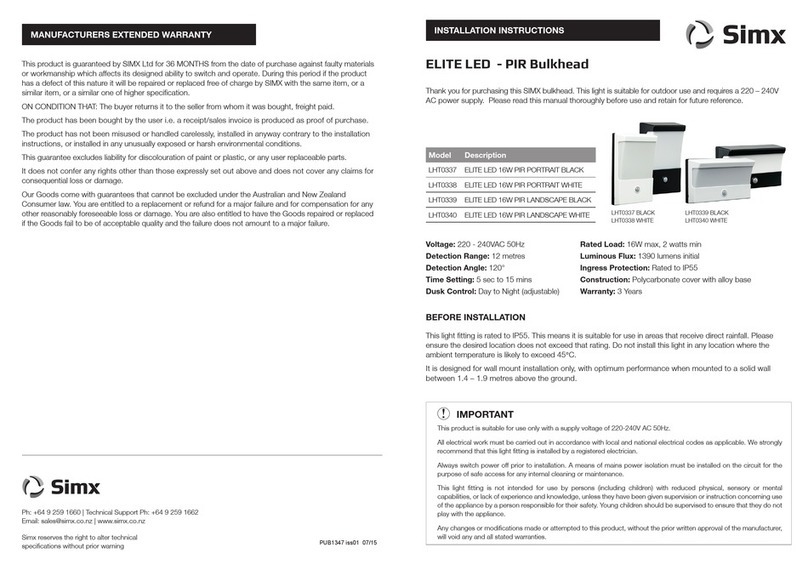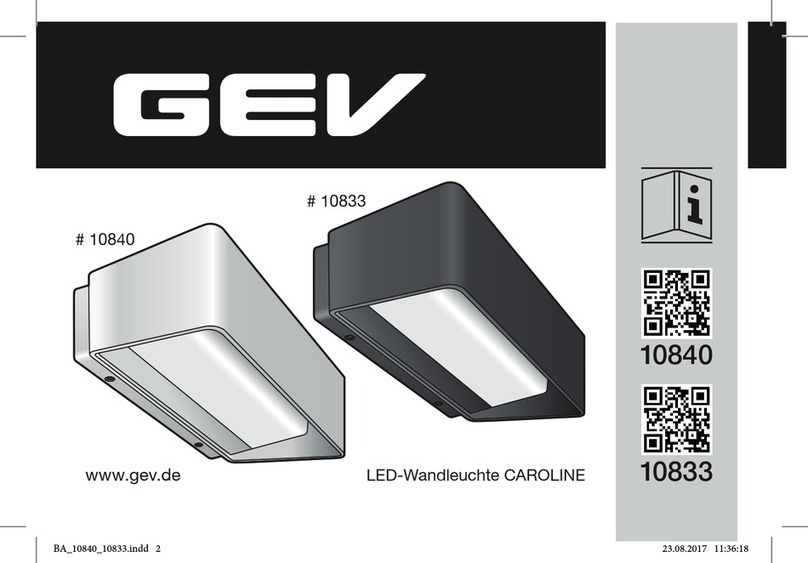
Cooper Crouse-Hinds GmbH
44
44
4
1. Sicherheitshinweise:
Zielgruppe:
Elekrofachkräfte und unterwiesene Personen.
- Die Leuchte darf nicht in den Zonen 0 und 20
eingesetzt werden!
- Die Anforderungen der EN 61241-0 und -1 u.a.
in Bezug auf übermäßige Staubablagerungen und
Temperatur, sind vom Anwender zu beachten.
- Die auf der Leuchte angegebenen technischen
Daten sind zu beachten!
- Umbauten oder Veränderungen an der Leuchte
sind nicht zulässig!
- Die Leuchte ist bestimmungsgemäß in
unbeschädigtem und einwandfreiem Zustand zu
betreiben!
- Als Ersatz dürfen nur Originalteile von Cooper
Crouse-Hinds (CCH)CEAG verwendet werden!
- Reparaturen, die den Explosionsschutz
betreffen, dürfen nur von CCH/CEAG oder einer
qualifizierten „Elektrofachkraft“ durchgeführt
werden!
- Lassen Sie diese Betriebsanleitung während
des Betriebes nicht in der Leuchte!
- Beachten Sie die nationalen Unfallverhütungs-
und Sicherheitsvorschriften und die nachfolgenden
Sicherheitshinweise, die in dieser Betriebsanleitung
mit einem ( ) gekennzeichnet sind!
2. Normenkonformität
Diese Leuchte ist zum Einsatz in explosions-
gefährdeten Bereichen der Zone 1,2, 21 und 22 ge-
mäß EN 60079-10 und IN 60079-14 geeignet.
Sie wurde entsprechend dem Stand der Technik und
gemäß DIN EN ISO 9001:2000 entwickelt, gefertigt
und geprüft.
Im Netzbetrieb werden alle Anforderungen der Normen
voll eingehalten. Im Notlichtbetrieb wird der in der
Norm festgelegte Wert der Störaussendung in einem
gewissen Frequenzbereich geringfügig überschritten.
Diese Überschreitung führt bei bestimmungsgemä-
ßem Gebrauch der Leuchte zu keinerlei Beeinträchti-
gung anderer Betriebsmittel.
-Achtung! Die Schutzscheibe ist nicht gegen
Herabfallen gesichert!
-Zum Schließen der Schutzscheibe Schrauben nur
handfest anziehen.(Prüfdrehmoment: 1,5 Nm)
Montageabmessungen: siehe Bild 13
Deckeneinbau (Bild 12 und 13)
Beachten Sie die Maße für den Deckenausschnitt!
1. Gewindebohrungen an der Rückseite
M8 x 18 mm tief zur Deckenmontage.
2. Deckeneinbau in ausreichend tragfähige
Deckenkonstruktionen: seitliche Befestigungs-
löcher im Rahmen mit geeigneten Schrauben
befestigen (Option)
3. Montagebügel zur stirnseitigen Befestigung
(Option) siehe Bild 12
Verwenden Sie keine zu langen Schrauben!
Montagezubehör: s. Cooper Crouse-Hinds-Katalog.
Netzanschluss
-Hängen sie die Schutzscheibe aus den
Scharnieren aus.
-Lösen sie die 4 Befestigungsschrauben am
Reflektor um ca. 3 Umdrehungen (Bild 5, 6)
-Schieben sie den Reflektor nach rechts aus der
Schraube heraus und entnehmen sie den
Reflektor (Bild 7).
-Lösen sie die Schutzleiterverbindung am
Klemmstein oder am Gehäuse (Bild 8). Achten
sie auf die Position der Zahnscheibe (Schrau-
benkopf, Kabelschuh, Zahnscheibe
-Führen Sie die Leitung durch die Ex-Kabel- und
Leitungseinführung ein.
Bei Benutzung der CCH/CEAG Leitungseinführung
M25 (PA) verwenden Sie für Leitungen von 8 bis
12 mm beide Dichtungseinsätze, von 12 bis 17 mm
nur den äußeren Dichtungseinsatz.
Achten Sie auf korrekten Sitz des verbleibenden
Dichtungseinsatzes in der Verschraubung.
-Klemmen Sie die Leitungen an den Anschluss-
klemmen L, L1, L2, L3, N, PE (Bild 10) gemäß
Klemmenbezeichnung an (Bild 11). Abisolierlänge
9-10 mm.
-Schließen sie die Schutzleiterverbindung am
Gehäuse an (Bild 8,9).
-Führen sie den Reflektor in die 4 Befestigungs-
schrauben ein (Bild 7)
-Beim Schließen des Reflektors ist darauf zu
achten, dass keine Leitungen eingequetscht
werden.
-Ziehen sie alle 4 Schrauben fest an.
-Erst danach die Leitungseinführung fest
anziehen
Hängen sie die Schutzscheibe in die Scharnier-
haken ein.
-Führen sie die Lampen in die Fassung ein.
Drücken sie dabei den Betätigungsknopf an der
Fassung (Bild 3a). Die Lampe muss fest in der
Lampenfassung sein. Prüfen sie den festen Sitz
durch leichtes Ziehen an der Lampe (Bild 3b)
-Verschließen sie die Schutzscheibe mit den
Verschlussschrauben (Bild 1)
Achtung
Bei nicht benutzten Kabel-und Leitungseinführungen
ist die Schutzscheibe zu entfernen und durch einen
Verschlussstopfen (Drehmoment 3,5 Nm) zu
verschließen.
Beim Verschließen mit einem Verschlussstopfen stets
beide Dichtungseinsätze verwenden!
Bei Metall-Kabeleinführungen sind die Schutzkappen
der nicht benutzten Einführungen zu entfernen und
durch bescheinigte Ex-Verschlussstopfen
(min. IP 65) zu verschließen!
Einsetzen der Lampe:
3. Technische Daten
EG-Baumusterprüfbe-
scheinigung: FTZÚ 08 ATEX 0188X
Kennzeichnung nach94/9/EG
II 2 G Ex e d mb IIC T4
II 2 D Ex tD A21 IP65 T60 °C
Batterietyp 18 W: 3,6 V / 4 Ah
36 W: 6,0 V / 4 Ah
Notlichtbetriebsdauer: 1,5 h / 3,0 h
(variantenabhängig)
Schutzklasse
nach EN 60 598: I
Schutzart nach EN 60529 IP65
zulässige Umgebungs-
temperatur -5 °C bis +40 °C
Lagertemperatur in der
Originalverpackung: -25 °C bis +60 °C
Lampenbestückung:
Zweistiftlampen-
fassung G13 nach
18 W IEC 60081-22/20
36 W IEC 60081-24/20
Klemmvermögen Anschluss-
klemme 2x je Klemme: 4 mm²
Klemmentyp: Steckklemme
Abisolierlänge: 9-10 mm
Leiterquerschnitt bei Durchgangs-
verdrahtung: 2,5 mm2für max. 16 A
Maximale Anzahl der Leuchten bei
Durchgangsverdrahtung
2x 18 W 12 Stck.
2x 36 W 8 Stck.
4x 18 W 8 Stck.
4x 36 W 3 Stck.
Ex e-Kabel- und Leitungseinführung
Standardausführung: M25x1,5 für Leitungen
Ø 8 bis 17 mm
Metall: M20x1,5 Innengewinde
Prüfdrehmoment für Ex-e Kabel- und
Leitungseinführung M25x1,5: 5,0 Nm
Prüfdrehmoment für Druck-
schraube: 3,5 Nm
(für Abdichtung Leitung
oder Verschlussstopfen)
Prüfdrehmoment für Scheiben-
Schlitzschraube: 1,5 Nm
Gewicht
18/36/ W (2-lampig): ca. 8,9/ 14,9 kg
18/36/ W (4-lampig): ca. 11,5/18,5 kg
4. Funktionelle Besonderheiten
Ladung der Batterie
Bei Netzbetrieb wird die Batterie der Leuchte durch
ein Konstantstrom-Ladeteil geladen.
Das Laden des Batterie wird durch die grüne, leuch-
tende Leuchtdiode im Reflektor angezeigt. Die Ladung
erfolgt über den ungeschalteten Außenleiter L, damit
sie auch bei ausgeschalteter Leuchte nicht unterbro-
chen wird. Der Ladestrom ist bei ordnungsgemäßem
Betrieb der Leuchte so bemessen, dass bei entlade-
ner Batterie innerhalb von 24 h ca. die Nennkapazität
erreicht wird. Er ist für eine Dauerladung der Batterie
geeignet.
Betriebsarten
Bei anliegender Netzspannung können die Lampen in
der Leuchte mit dem Leuchtenschalter ein- und aus-
geschaltet werden.
5. Installation
Halten Sie die für das Errichten und Betreiben
von explosionsgeschützten elektrischen Betriebsmit-
teln geltenden Sicherheitsvorschriften gemäß des
Gerätesicherheitsgesetzes sowie die allgemein
anerkannten Regeln der Technik ein!
Transport und Lagerung der Leuchte ist nur in
Originalverpackung und angegebener Lage gestattet!
Öffnen und Schließen der Leuchte
-Die Schlitzschrauben mit geeignetem Schrauben-
dreher lösen und Schutzscheibe abklappen, siehe
Bild 1 und 2.




